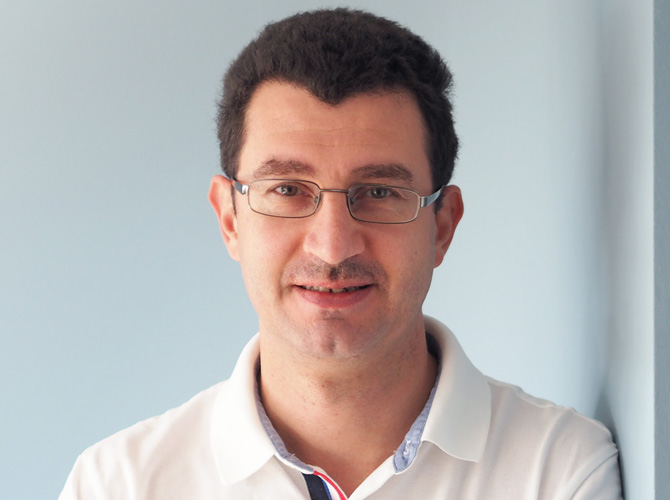Dr. Günther wurde 1975 in Rochlitz/ Sachsen geboren. Das Medizinstudium durchlief er von 1994 bis 2000 an der Medizinischen Fakultät der TU Dresden. 2001 promovierte er zum „Dr. med.“. Seine klinische Ausbildung erhielt er im Herzzentrum an der TU Dresden bei Frau Prof. Strasser und schloss diese mit dem Erwerb des Facharzttitel „Innere Medizin und Kardiologie“ ab. Seit 2009 war Herr Dr. Günther als Oberarzt in der Klinik Innere Medizin und Kardiologie tätig.
Tätigkeits- und Forschungsschwerpunkt ist zum einen die Behandlung erkrankter Herzkranzgefäße durch Herzkatheter als auch insbesondere die Implantation von Herzschrittmachern und Defibrillatoren. In der Etablierung neuer und innovativer Methoden zur Behandlung der Herzschwäche- und Bluthochdruckerkrankungen, wie kardiale Kontraktilitätsmodulation (CCM), Barorezeptorstimulation und Nervus vagus Stimulation, ist Dr. Günther maßgeblich mitbeteiligt. Besondere Expertise besitzt Dr. Günther in der Behandlung der Herzschwäche durch die Implantation von Geräten zur kardialen Resynchronisation.
Dr. Günther ist im Besitz der der Zusatzqualifikation „Invasive Kardiologie“ und „Spezielle Rhythmologie“, vergeben durch die Deutsche Gesellschaft für Kardiologie (DGK).
1) Experience With the Wearable Cardioverter-Defibrillator in Patients at High Risk for Sudden Cardiac Death.
Wäßnig NK, Günther M, Quick S, Pfluecke C, Rottstädt F, Szymkiewicz SJ, Ringquist S, Strasser RH, Speiser U.
Circulation. 2016 Aug 30;134(9):635-43.
2) Heart-type fatty acid-binding protein and myocardial creatine kinase enable rapid risk stratification in normotensive patients with pulmonary embolism
Langer M, Forkmann M, Richter U, Tausche AK, Sveric K, Christoph M, Ibrahim K, Günther M, Kolschmann S, Boscheri A, Barthel P, Strasser RH, Wunderlich C.
J Crit Care. 2016 Oct;35:174-9.
3) Target temperature management of 33 degrees C exerts beneficial haemodynamic effects after out-of-hospital cardiac arrest
Forkmann M, Kolschmann S, Holzhauser L, Ibrahim K, Guenther M, Christoph M, Fuhrmann JT, Boscheri A, Schmeiβer A, Strasser RH, Wunderlich C.
Acta Cardiol. 2015 Aug;70(4):451-9.
4) Substernal lead implantation: a novel option to manage DFT failure in S-ICD patients.
Guenther M, Kolschmann S, Knaut M.
Clin Res Cardiol. 2015 Feb;104(2):189-91.
5) Acute coronary syndrome and single coronary artery ostium.
Speiser U, Ende G, Quick S, Waessnig NK, Wiedemann S, Platzek I, Strasser RH, Guenther M.
Kardiol Pol. 2014;72(5):467.
6) Pre-hospital discharge testing of defibrillator without anesthesia: effects on psychological symptoms during clinical follow-up.
Petrowski K, Wintermann GB, Petzold C, Strasser RH, Guenther M.
Psychosom Med. 2013 Sep;75(7):640-9.
7) Implantable cardioverter defibrillator lead implantation in patients with a persistent left superior vena cava–feasibility, chances, and limitations: representative cases in adults.
Guenther M, Kolschmann S, Rauwolf TP, Christoph M, Sandfort V, Strasser RH, Wunderlich C.
Europace. 2013 Feb;15(2):273-7.
8) Amiodarone induced interatrial electrical dissociation mimics restored sinus rhythm in patient with persistent left atrial flutter.
Christoph M, Guenther M, Wunderlich C.
Heart. 2012 May;98(10):830.
9) Pre-hospital discharge testing after implantable cardioverter defibrillator implantation: a measure of safety or out of date? A retrospective analysis of 975 patients.
Guenther M, Rauwolf T, Brüggemann B, Gerlach M, Wässnig NK, Christoph M, Braun MU, Strasser RH, Wunderlich C.
Europace. 2012 Feb;14(2):217-23.
10) Intracranial hemorrhage causes a transmural myocardial infarction without the presence of coronary atherosclerosis.
Ibrahim K, Jellinghaus S, Christoph M, Pfluecke C, Guenther M, Ney M, Baretton G, Schoen S, Strasser RH.
Int J Cardiol. 2011 Oct 20;152(2):e40-1
11) Magnetic resonance imaging and intravascular ultrasound detect thrombus-loaded intimal dissection in a patient with normal coronary angiography.
Speiser U, Guenther M, Schoen SP.
Eur Heart J. 2010 Nov;31(21):2689.
12) A rare type of ventricular oversensing in ICD therapy–inappropriate ICD shock delivery due to triple counting.
Guenther M, Rauwolf TP, Bock M, Strasser RH, Braun MU.
Pacing Clin Electrophysiol. 2010 Feb;33(2
13) Beans in the pericardium.
Guenther M, Wunderlich C, Madisch A, Altmann O, Bergert H, Gastmeier J, Simonis G, Strasser RH.
Lancet. 2009 Aug 15;374(9689):586.
14) Twiddler’s syndrome in an adolescent patient with ICD during neurological and physical rehabilitation.
Herold J, Guenther M, Strasser RH, Braun M.
Clin Res Cardiol. 2009 Feb;98(2):137-9.
15) Ventricular oversensing in 518 patients with implanted cardiac defibrillators: incidence, complications, and solutions.
Rauwolf T, Guenther M, Hass N, Schnabel A, Bock M, Braun MU, Strasser RH.
Europace. 2007 Nov;9(11):1041-7.
Buchbeiträge:
Günther, M.; Rauwolf, T.; Strasser, R.H.: Therapierelevante Herzrhythmusstörungen in der Intensivmedizin unter besonderer Berücksichtigung von Patienten mit implantierten Schrittmachern und Defibrillatoren. In: Intensivmedizin., 38. Ergänzungslieferung (2010), S. 1–26
Gerlach, M.; Guenther, M.; Rauwolf, T.; Kolschmann, S.; Therapieoptionen in der fortgeschrittenen chronischen Herzinsuffizienz. In: Intensivmedizin – Kompendium und Repetitorium zur interdisziplinären Weiter- und Fortbildung. (2014), S. 1–17

